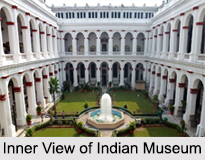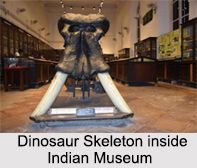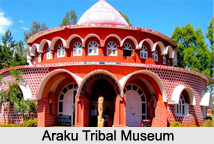 Indian Museum in Kolkata West Bengal is a versatile and multi disciplinary institution of national importance. The Museum was established at the Asiatic Society, the initial learned body in the country on 2nd February 1814. Later it was transferred to the present building in 1878 with two galleries.
Indian Museum in Kolkata West Bengal is a versatile and multi disciplinary institution of national importance. The Museum was established at the Asiatic Society, the initial learned body in the country on 2nd February 1814. Later it was transferred to the present building in 1878 with two galleries.
History of Indian Museum
The Indian Museum originated from the Asiatic Society of Bengal, which was created by Sir William Jones in 1784. The concept of having a museum was first created in 1796 from the members of the Asiatic Society as a place where man-made and natural objects could be collected, cared and displayed. The plan was first initiated in 1808 when the Society was offered suitable accommodation by the Government of India in the Chowringhee-Park Street area.
Infrastructure of Indian Museum
The Museum has now over sixty galleries of Art, Archaeology, Anthropology, Geology, Zoology and Botany sections, spreading over 10,000 square feet area. Many rare specimens both Indian and Trans - Indian origin relating to Humanities and Natural Science are conserved and displayed in the galleries of these sections. The administrative control of the cultural sections- Art, Archaeology and Anthropology rest with the Board of Trustees under its Directorate, and that of the three scientific sections are with Geological Survey of India, Zoological Survey of India and Botanical Survey of India. Indian Museum is an autonomous institution fully funded by the Department of Culture, Government of India.
Departments of Indian Museum
Indian Museum is structured in six prime sections. The sections are Art, Archaeology, Anthropology, Zoology, Geology, and Botany. Some of the sections are detailed below:
Anthropological Section: This section displays several items like the costumes, ornaments, and equipment of the various tribes and also gives a close sight of the cultural life of both tribal and non-tribal people of India. There is also a gallery of rare musical instruments.
 Archaeological Section: It comprises the collection of stone-age artifacts from India and abroad, pre-historic antiquities from Mohenjodaro, Harappa etc. Some of the galleries in this section are Bharhut, Egyptian, Coins, Orissan Art and Gandhara.
Archaeological Section: It comprises the collection of stone-age artifacts from India and abroad, pre-historic antiquities from Mohenjodaro, Harappa etc. Some of the galleries in this section are Bharhut, Egyptian, Coins, Orissan Art and Gandhara.
Bharhut gallery displays the railings and entrance of the Buddhist Stupa with carvings and sculptures depicting scenes from Buddha`s life excavated from Bharhut in Madhya Pradesh in 1874 by Sir Alexander Cunningham. There is also a vase containing Buddha`s ashes; due to which, the museum has become a place of pilgrimage.
Gandhara gallery holds the best collection of Buddhist Sculptures from Gandhara region and other stone sculptures. The Egyptian gallery has a 4000-year-old `mummy`, sculptures, paintings etc. The coin gallery has a collection of coins from the 5th century B.C, which displays gold coins issued by Kanishka, Samudragupta, Kumaragupta, Akbar and Jahangir.
Art Section: This section has galleries including textile, painting and decorative art objects. They are from China, Japan, Burma, Nepal and Tibet etc. The exhibits in the art section comprises Nepalese and Tibetan temple banners, metal images, enamelled wares, bidriwares, ornaments, silver wares, glass wares, pottery, ivory and bone work, wooden sculptures etc.
The painting gallery has a rich display of Mughal Miniature Paintings, Kangra-Kalam Paintings, Kalighat Patas from Bengal and a section of works of famous painters from Bengal. Along with the collection of Nepalese and Tibetan Thankas dated from 15th to 19th century, the textile gallery has a display of Muslin and Jamdani from Dhaka, Persian Carpets, Phulkari work of Punjab, Kantha work from Bengal, rumal (handkerchiefs) from Chamba in Himachal Pradesh etc.
South East Asian gallery of the Art section has three separate galleries for artifacts from China-Japan, Burma and Nepal-Tibet. In China-Japan Art gallery there are coloured porcelains, wine cups, ivory and rhinoceros horn carved articles, paintings etc. Burmese gallery displays brass and bronze figures, woodcarvings, silverwares and lacquer ware objects depicting `Jatakas`, scenes from the epic `Ramayana` etc. Nepal-Tibet gallery houses bronze figures and woodcarvings from 9th to 19th century, apron made of human bones, butter-lamp, ornaments etc.
 Geological Section: The wide Geological Section has over 80,000 specimens, displayed in four galleries showing varieties of meteorites, precious stones, ornamental building stones, rocks and minerals and fossils. The sections dealing with fossil and taxidermy are notable. There are a number of unique fossil skeletons of prehistoric animals and an enormous dinosaur skeleton. Among them the most interesting are a giant crocodile and an amazingly big tortoise.
Geological Section: The wide Geological Section has over 80,000 specimens, displayed in four galleries showing varieties of meteorites, precious stones, ornamental building stones, rocks and minerals and fossils. The sections dealing with fossil and taxidermy are notable. There are a number of unique fossil skeletons of prehistoric animals and an enormous dinosaur skeleton. Among them the most interesting are a giant crocodile and an amazingly big tortoise.
Botanical Section: This section has several botanical specimens bearing upon medicine, forestry, agriculture and cottage industry.
Library of Indian Museum
The Indian Museum displays a vast collection of some 50,000 books and journals along with many rare publications. Books and Journals are available on Museology, Archaeology, Anthropology and Art etc. In a nutshell, the Indian Museum in Kolkata reveals the life and culture of all the ancient ages.













